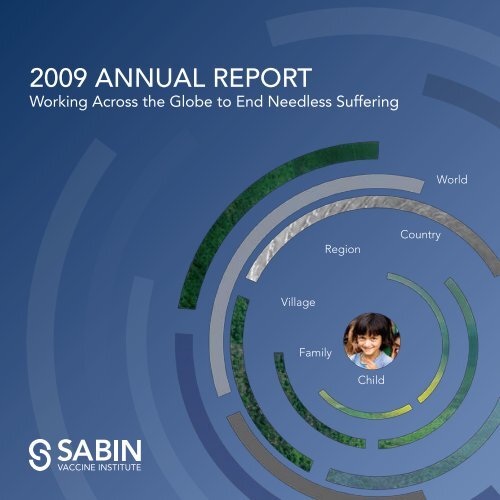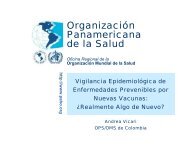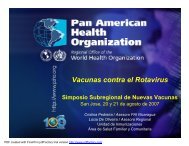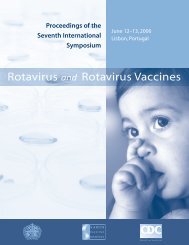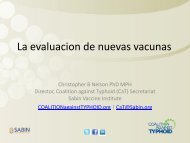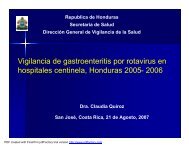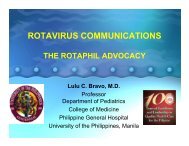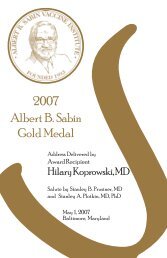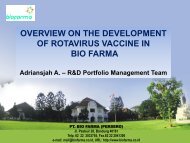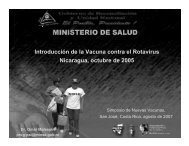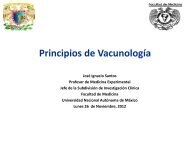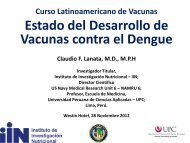2009 AnnuAl RepoRt - Sabin Vaccine Institute
2009 AnnuAl RepoRt - Sabin Vaccine Institute
2009 AnnuAl RepoRt - Sabin Vaccine Institute
Create successful ePaper yourself
Turn your PDF publications into a flip-book with our unique Google optimized e-Paper software.
<strong>2009</strong> Annual Report<br />
Working Across the Globe to End Needless Suffering<br />
World<br />
Region<br />
Country<br />
Village<br />
Family<br />
Child
Table of Contents<br />
Letter from the Chairman and CEO 2<br />
Message from the President 3<br />
About Us 4<br />
Our Programs 5<br />
<strong>Sabin</strong> <strong>Vaccine</strong> Development 6<br />
<strong>Vaccine</strong> Advocacy and Education 12<br />
Global Network for Neglected Tropical Diseases 18<br />
The Writings of <strong>Sabin</strong> Scholars 24<br />
<strong>Sabin</strong> Scholars Honored 25<br />
Board of Trustees 26<br />
Staff 27<br />
Financial Report 28<br />
“A scientist who is also a human being<br />
cannot rest while knowledge which might<br />
reduce suffering rests on the shelf.”<br />
A Summary of the Diseases We Fight 30<br />
The Seven Most Common NTDs 31<br />
Albert B. <strong>Sabin</strong>, MD<br />
<strong>Sabin</strong> <strong>Vaccine</strong> <strong>Institute</strong> | 1
Letter from the Chairman and CEO<br />
Dear <strong>Sabin</strong> Supporters,<br />
We are pleased to present the <strong>Sabin</strong> <strong>Vaccine</strong> <strong>Institute</strong>’s <strong>2009</strong> Annual Report “Working Across the Globe to End Needless<br />
Suffering.” In the spirit of science in pursuit of humanitarian goals, <strong>Sabin</strong> has been engaged in almost a dozen major projects<br />
with an emphasis on controlling and eliminating infectious and neglected tropical diseases (NTDs).<br />
With funding from the Bill & Melinda Gates Foundation, the Global Network for Neglected Tropical Diseases continues to<br />
raise awareness and resources to increase access to existing medicines that can control and over time, eliminate the seven<br />
most common NTDs for approximately 50 cents per person, per year. These diseases of antiquity, referenced in the Bible<br />
and other ancient texts, are no longer health threats in the developed world, but continue to wreak havoc on the poorest<br />
and most marginalized communities, the world’s “bottom billion.”<br />
Our unwavering commitment to developing low-cost vaccines for infections and diseases that devastate these impoverished<br />
communities around the global continues. <strong>Sabin</strong> <strong>Vaccine</strong> Development continued research and development, with The<br />
George Washington University and other partners, of the first-ever recombinant vaccines to combat hookworm and<br />
schistosomiasis. Our scientists have recently partnered with PATH Malaria <strong>Vaccine</strong> Initiative and others to develop a<br />
transmission blocking malaria vaccine.<br />
Message from the President<br />
Dear Friends,<br />
This has been a transformative year for <strong>Sabin</strong>. The addition of new leadership and staff has enabled us to expand our reach<br />
in areas core to our mission, while the growth of our programs reflects remarkable progress in realizing our vision of making<br />
a tangible difference in the lives of hundreds of millions of people suffering from infectious and neglected tropical diseases<br />
(NTDs). We are at a watershed moment of increasing innovation, research, and awareness.<br />
The control and eventual elimination of these diseases demand solutions that are nimble, strategies that can be adapted to<br />
different cultures and countries, and leadership that embraces collaboration with partners of all types, each a component of<br />
the <strong>Sabin</strong> model. We have played a major role in making NTDs a global health priority and we continue our work to increase<br />
access and affordability of treatments and vaccines, while strengthening our established product development partnerships<br />
to develop vaccines that are desperately needed, but don’t yet exist.<br />
In the coming year, clinical trials will be initiated for the human hookworm infection antigen Na-GST-1, a key advance for<br />
the <strong>Sabin</strong> <strong>Vaccine</strong> Development team. Also, the schistosomiasis antigen Sm-TSP-2 will be manufactured by our partner,<br />
Instituto Butantan in Brazil. Vital to both vaccines are partnerships with Brazil’s Fundaçao Oswaldo Cruz and the Brazilian<br />
Health Ministry.<br />
Identifying innovative financing solutions for immunizations and promoting awareness and utilization of vaccines against<br />
killer infectious diseases remains the core objective of our <strong>Vaccine</strong> Advocacy and Education initiatives. The Pneumococcal<br />
Awareness Council of Experts (PACE) led several events around the world, using World Pneumonia Day to call attention<br />
to the world’s leading killer of children. Our Sustainable Immunization Financing (SIF) program brought together ministers<br />
of health and finance and parliamentarians in 15 countries to encourage policymakers to increase funding of national<br />
immunization programs.<br />
We hope that you will be encouraged by the tremendous opportunities to contribute to poverty alleviation through<br />
the innovative and scientifically supported approaches of <strong>Sabin</strong>. We express our deep appreciation to those who have<br />
generously supported our work. There is much to be done, but with your support we believe that attainment of our vision<br />
will not be far away.<br />
Sincerely,<br />
Through the Global Network for Neglected Tropical Diseases, we have the opportunity to control or eliminate several of<br />
the seven most common NTDs and to lift “the bottom billion” out of extreme poverty. The short-term solution to defeating<br />
NTDs rests in increased funding, which would result in improved school attendance, worker productivity and better maternal<br />
and child health.<br />
Our <strong>Vaccine</strong> Advocacy and Education team will continue its work with policymakers and global health stakeholders to<br />
increase the use of vaccines that already exist for deadly illnesses such as HPV, pertussis, rotavirus, and pneumococcal<br />
disease. South Africa will be the site of two important forums in 2010. In August, the 9th Rotavirus Symposium will bring<br />
together stakeholders from over 20 countries. In the fall of 2010, our Sustainable Immunization Financing program will<br />
bring together representatives from 15 countries for a forum on immunization financing.<br />
The need is great; our collective capacity is greater. <strong>Sabin</strong> will continue its commitment to<br />
eliminating and controlling infectious and neglected tropical diseases. I look forward to your<br />
ongoing support and engagement with the <strong>Institute</strong> as we strive to reach our mission.<br />
Sincerely,<br />
2 | <strong>2009</strong> Annual Report<br />
Morton P. Hyman<br />
Chairman<br />
Michael W. Marine<br />
Chief Executive Officer<br />
Peter J. Hotez, MD, PhD<br />
President<br />
<strong>Sabin</strong> <strong>Vaccine</strong> <strong>Institute</strong> | 3
About Us<br />
We’re scientists.<br />
We’re researchers.<br />
And we’re advocates for a world free of needless suffering.<br />
The <strong>Sabin</strong> <strong>Vaccine</strong> <strong>Institute</strong> (<strong>Sabin</strong>) is a non-profit, 501(c)(3) organization dedicated to reducing needless human<br />
suffering from infectious and neglected tropical diseases through prevention and treatment. <strong>Sabin</strong> works with<br />
governments, academic institutions, scientists, medical professionals, and non-profit organizations to provide<br />
short and long-term solutions for some of the globe’s toughest health care challenges.<br />
Since its establishment in 1993, <strong>Sabin</strong> has been at the forefront of global efforts to eliminate, prevent and cure<br />
infectious and neglected tropical diseases by developing new vaccines, establishing international networks and<br />
advocating for effective and efficient delivery of preventions and treatments to the world’s poor.<br />
<strong>Sabin</strong> was founded on the legacy and global vision of one of medicine’s most<br />
pre-eminent scientific figures, Dr. Albert B. <strong>Sabin</strong>, best known for developing the oral<br />
live virus polio vaccine. Dr. <strong>Sabin</strong> not only dedicated his entire professional career to<br />
groundbreaking medical advancements to reduce human suffering, he also waged a<br />
lifelong campaign against poverty and ignorance.<br />
The <strong>Institute</strong> continues Dr. <strong>Sabin</strong>’s vision by providing greater access to vaccines and<br />
essential treatments for hundreds of millions of people stuck in a cycle of pain, poverty<br />
and despair through its three main programs – <strong>Sabin</strong> <strong>Vaccine</strong> Development, the Global<br />
Network for Neglected Tropical Diseases, and <strong>Vaccine</strong> Advocacy and Education. Through<br />
these three distinct yet complementary programs, the <strong>Institute</strong> continues Dr. <strong>Sabin</strong>’s<br />
lifelong efforts to develop preventive measures for diseases that place heavy burdens on<br />
the world’s poorest countries.<br />
The <strong>Sabin</strong> Mission<br />
To reduce needless human suffering from infectious<br />
and neglected tropical diseases through innovative<br />
vaccine research and development; and to advocate<br />
for improved access to vaccines and essential<br />
medicines for citizens around the globe.<br />
Government<br />
Science<br />
Research<br />
<strong>Vaccine</strong><br />
Community<br />
Advocacy<br />
<strong>Sabin</strong> <strong>Vaccine</strong> <strong>Institute</strong><br />
<strong>Vaccine</strong> Advocacy & Education<br />
Global Network<br />
<strong>Sabin</strong> <strong>Vaccine</strong> Development<br />
Partnership<br />
Science<br />
Government<br />
Partnership<br />
Research<br />
<strong>Vaccine</strong><br />
Advocacy<br />
Community<br />
About Us<br />
<strong>Sabin</strong> <strong>Vaccine</strong> <strong>Institute</strong> | 5
<strong>Sabin</strong> <strong>Vaccine</strong> Development<br />
Who We Are<br />
<strong>Sabin</strong> <strong>Vaccine</strong> Development is a product development partnership (PDP), headquartered at the <strong>Sabin</strong><br />
<strong>Vaccine</strong> <strong>Institute</strong>, leveraging industry practices to produce a new generation of antipoverty vaccines.<br />
<strong>Sabin</strong> <strong>Vaccine</strong> Development has built the infrastructure and capacity for research, development, and<br />
manufacture of potential vaccine candidates. Under the leadership of Dr. Peter Hotez, the program has<br />
a strong management and administrative core experienced in vaccine development, quality assurance,<br />
regulatory affairs, and clinical trials.<br />
<strong>Sabin</strong> <strong>Vaccine</strong> Development is an international collaboration comprised of The George Washington<br />
University (GW) in the United States, Fundaçao Oswaldo Cruz (FIOCRUZ) and Instituto Butantan in Brazil,<br />
James Cook University in Australia, the London School of Hygiene and Tropical Medicine (LSHTM) in the<br />
United Kingdom, and The <strong>Institute</strong> of Parasitic Diseases at the Chinese Center for Disease Control and<br />
Prevention in China.<br />
What We Do<br />
With ten years of experience, we have produced a well-rounded model that serves as<br />
a blueprint for the development of safe and effective vaccines against infectious and<br />
neglected tropical diseases. Existing capabilities include:<br />
• Product Development: We have established the infrastructure to engage in antigen<br />
discovery, rapid development of scalable manufacturing processes (process development),<br />
quality control, preclinical and clinical immunology and stability testing.<br />
• Technology Transfer and Manufacturing: We work with manufacturers in both Brazil<br />
and the United States to scale up developed processes for manufacture of pilot<br />
clinical lots under current good manufacturing practices (cGMP).<br />
• Epidemiological and Clinical Studies: We have established a field laboratory and<br />
field clinical site, including a vaccine testing center in the endemic region of<br />
Americaninhas in the Brazilian state of Minas Gerais, for the conduct of clinical<br />
trials, including Phase 1 (first in human trials).<br />
Hookworm infection<br />
antigen manufactured for<br />
toxicological and clinical<br />
use in Brazil where 32<br />
million of the estimated<br />
600 million global<br />
hookworm cases occur<br />
in populations surviving<br />
on an income of less than<br />
$1.25 a day.<br />
• Ethical and Regulatory Approvals:<br />
We have completed Phase 1 clinical<br />
trials with ethical oversight from<br />
institutional review boards in the<br />
United States and Brazil and obtained<br />
regulatory approval for clinical testing<br />
from the U.S. Food and Drug<br />
Administration (FDA) and Brazilian<br />
regulatory agency, the Agência Nacional<br />
de Vigilância Sanitária (ANVISA).<br />
LSHTM (UK)<br />
(Global Health Impact)<br />
Epidemiology<br />
Mathematical Modeling<br />
Cost-effectiveness<br />
Analysis<br />
FIOCRUZ (Brazil)<br />
(Clinical Trials)<br />
Clinical Testing<br />
Field epidemiology<br />
Clinical immunology<br />
GW (U.S.)<br />
(R&D)<br />
Molecular Biology<br />
Process Development<br />
Formulation & Testing<br />
Animal Testing<br />
Clinical Immunology<br />
<strong>Sabin</strong> (U.S.)<br />
(Program Operations)<br />
Management &<br />
Administration<br />
Regulatory Affairs<br />
Quality Assurance<br />
Clinical Development &<br />
Oversight<br />
James Cook<br />
University<br />
(Australia)<br />
(R&D)<br />
Antigen Discovery<br />
Animal Efficacy Studies<br />
Assay Development<br />
National <strong>Institute</strong><br />
of Parasitic Diseases,<br />
Chinese CDC (PRC)<br />
(R&D)<br />
Preclinical Challenge<br />
Studies<br />
Instituto Butantan<br />
(Brazil)<br />
(Manufacturing)<br />
Technology Transfer<br />
cGMP manufacturing<br />
<strong>Sabin</strong> <strong>Vaccine</strong> Development<br />
<strong>Sabin</strong> <strong>Vaccine</strong> <strong>Institute</strong> | 7
4 vaccine antigens in<br />
“The Ministry recognizes<br />
development for 3 parasitic<br />
diseases which afflict<br />
over 1 billion individuals<br />
primarily residing in the<br />
developing world.<br />
A scientist from FIOCRUZ looks<br />
into a microscope at <strong>Sabin</strong><br />
<strong>Vaccine</strong> Development’s clinical<br />
trial site in Minas Gerais, Brazil.<br />
Our Programs<br />
The Human Hookworm <strong>Vaccine</strong> Initiative (HHVI)<br />
With financial support from the Bill & Melinda Gates Foundation, the HHVI was launched<br />
in 2000 as the world’s first-ever vaccine program targeting human hookworm infection.<br />
A hookworm vaccine would alleviate suffering for more than a half-billion infected<br />
people. Globally, an estimated 3.2 billion people are at risk, including hundreds of<br />
millions of children and 44 million pregnant women. Hookworms are intestinal worms<br />
that cause blood loss in the gut, leading to iron-deficiency anemia and protein malnutrition,<br />
particularly in children and pregnant women. Chronic<br />
hookworm infection in children contributes to physical and<br />
intellectual impairment, learning difficulties and poor school<br />
performance. This often leads to an under-achieving workforce<br />
in already economically depressed communities, thereby<br />
perpetuating the cycle of poverty.<br />
The HHVI has identified several candidate antigens for the<br />
human hookworm vaccine. Two of these promising antigens will<br />
soon be ready for clinical trials: Na-GST-1 was manufactured<br />
in the fall of <strong>2009</strong> and will be ready for clinical testing in late<br />
2010, and Na-APR-1 is scheduled to be manufactured in 2011.<br />
Following independent safety testing of each antigen, the<br />
human hookworm vaccine under development will ultimately<br />
incorporate both the Na-GST-1 and Na-APR-1 antigens in a<br />
bivalent vaccine together with an adjuvant.<br />
The Schistosomiasis <strong>Vaccine</strong> Initiative (SVI)<br />
The development of a vaccine for schistosomiasis has the potential to improve the<br />
lives of more than 200 million people in 74 countries worldwide. Schistosomiasis, also<br />
known as bilharzia or “snail fever,” is a parasitic disease carried by fresh water snails.<br />
The SVI was launched in 2008 through a generous donation by Mort and Chris Hyman,<br />
and funding from the Blavatnik Charitable Foundation. The goal of the SVI is to utilize<br />
and leverage <strong>Sabin</strong>’s existing programmatic and technical infrastructure in vaccine<br />
development to produce a safe and cost-effective schistosomiasis vaccine.<br />
In collaboration with researchers at Queensland <strong>Institute</strong> of Medical Research (now<br />
at James Cook University), a promising new antigen, Sm-TSP-2 (Schistosoma mansoni<br />
Tetraspanin-2), has been selected for research. Evidence from studies of the human<br />
immune response to schistosomiasis in endemic areas and from preclinical animal<br />
studies suggest that vaccination with this antigen may induce protective immunity<br />
against infection by this parasite. In 2010, SVI plans to manufacture clinical product<br />
at Instituto Butantan, <strong>Sabin</strong>’s manufacturing partner in Brazil.<br />
The Malaria <strong>Vaccine</strong> Program (MVP)<br />
PATH Malaria <strong>Vaccine</strong> Initiative (MVI), <strong>Sabin</strong> <strong>Vaccine</strong> Development, and The Johns<br />
Hopkins Bloomberg School of Public Health have formed an 18-month research<br />
collaboration to aid in the development of a transmission-blocking malaria vaccine<br />
antigen. MVI is funded primarily by the Bill & Melinda Gates Foundation and aims<br />
to develop malaria vaccines and ensure their availability and accessibility to people<br />
in the developing world.<br />
With the investment from MVI, <strong>Sabin</strong> <strong>Vaccine</strong> Development will utilize its existing<br />
product development capabilities at The George Washington University to optimize<br />
the expression of Anopheline alanyl aminopeptidase-1 (AnAPN-1) in either yeast or<br />
a bacterial vector. Once the expression system is determined, researchers at GW will<br />
develop a manufacturing process to produce the AnAPN-1 antigen, as well as the<br />
release and stability tests necessary to test its identity, purity, potency and stability.<br />
The successful development of AnAPN-1 will potentially yield an important tool to aid<br />
in the control and eradication of malaria.<br />
the decade-long commitment<br />
by <strong>Sabin</strong> and<br />
the Human Hookworm<br />
<strong>Vaccine</strong> Initiative (HHVI)<br />
to foster development<br />
in Brazil, in collaboration<br />
with FIOCRUZ and<br />
Instituto Butantan. We<br />
also acknowledge your<br />
efforts to build capacity<br />
with these institutions<br />
in regards to vaccine<br />
product development<br />
and clinical testing.”<br />
- Dr. Reinaldo<br />
Guimarães, Brazilian<br />
Ministry of Health<br />
Schistosomiasis is second only to malaria as the most deadly parasitic disease in the<br />
world, and kills approximately 280,000 people annually. The parasite can live inside<br />
human blood vessels for years, causing severe blood loss, anemia and malnutrition.<br />
Long-term schistosomiasis infections can also cause severe kidney, spleen and liver<br />
damage and can contribute to the development of bladder cancer, while in women<br />
female genital schistosomiasis leads to increased susceptibility to HIV/AIDS.<br />
8 | <strong>2009</strong> Annual Report<br />
<strong>Sabin</strong> <strong>Vaccine</strong> Development<br />
<strong>Sabin</strong> <strong>Vaccine</strong> Development<br />
<strong>Sabin</strong> <strong>Vaccine</strong> <strong>Institute</strong> | 9
<strong>Sabin</strong> <strong>Vaccine</strong> Development<br />
Human Hookworm <strong>Vaccine</strong> Initiative Receives A Commitment<br />
from Brazilian Government in Support of Clinical Trials<br />
In July <strong>2009</strong>, the Brazilian government notified <strong>Sabin</strong> of a financial commitment for<br />
translational research on neglected tropical diseases (NTDs) that will support the HHVI’s<br />
vaccine development program in Brazil. This pledge is part of a broad new initiative launched<br />
by the federal government called the Programa de Aceleração do Crescimento (Program for<br />
Accelerated Growth), and seeks to facilitate the translation of basic science discoveries for<br />
NTDs that are important in Brazil into new vaccines, drugs and diagnostics. It also recognizes<br />
the decade of collaboration between the HHVI and Brazilian organizations such as FIOCRUZ<br />
and Instituto Butantan, and <strong>Sabin</strong>’s commitment to fostering vaccine development and<br />
Manufacture of Human Hookworm <strong>Vaccine</strong> at AERAS Completed<br />
In the fall of <strong>2009</strong>, <strong>Sabin</strong> <strong>Vaccine</strong> Development partnered with the AERAS Global TB <strong>Vaccine</strong><br />
Foundation to manufacture the Na-GST-1 Hookworm <strong>Vaccine</strong> at its Rockville, MD production<br />
facility. AERAS is a non-profit product development partnership (PDP) funded primarily<br />
by the Bill & Melinda Gates Foundation. This state-of-the-art GMP-compliant facility has the<br />
capacity to produce up to 200 million doses of recombinant Bacillus Calmette-Guérin (BCG)<br />
tuberculosis vaccine per year, and is geared toward vaccine production and distribution at<br />
the lowest possible cost. Both of these factors make AERAS an ideal partner in the production<br />
of NTD vaccines, and one lot of Na-GST-1 Hookworm <strong>Vaccine</strong> has been produced for<br />
toxicological and clinical use.<br />
clinical testing in Brazil.<br />
The successful manufacture of the Na-GST-1 Hookworm <strong>Vaccine</strong> is an important step towards<br />
The funds will be used to invest in<br />
infrastructure and capacity building for<br />
hookworm and schistosomiasis vaccine<br />
development at the clinical laboratories of<br />
Centro de Pesquisas René Rachou (CPqRR/<br />
Fiocruz Belo Horizonte) and the clinical trial<br />
field site in Minas Gerais, both of which are<br />
operated as a collaboration between the<br />
the eventual creation of a bivalent vaccine candidate for hookworm. Immunization with<br />
Na-GST-1 Hookworm <strong>Vaccine</strong> may interfere with the ability of adult hookworms to digest<br />
hemoglobin, therefore inhibiting their ability to feed and produce eggs. This may result in<br />
a less severe infection and a reduction in<br />
the chronic adverse health effects of this<br />
parasite. Clinical trials for this promising<br />
candidate are scheduled to begin in Brazil<br />
in late 2010.<br />
HHVI and FIOCRUZ.<br />
Paula A. Freitas pipettes at the labs of FIOCRUZ.<br />
Dr. Ricardo Fujiwara of FIOCRUZ completes the<br />
first step of subject blood sample preparation.<br />
10 | <strong>2009</strong> Annual Report<br />
<strong>Sabin</strong> <strong>Vaccine</strong> Development<br />
<strong>Sabin</strong> <strong>Vaccine</strong> Development<br />
<strong>Sabin</strong> <strong>Vaccine</strong> <strong>Institute</strong> | 11
<strong>Vaccine</strong> Advocacy and Education<br />
Who We Are<br />
The <strong>Vaccine</strong> Advocacy and Education team is motivated by the number of lives that can be saved and the extraordinary<br />
personal and community benefits gained through widespread immunization. We recognize that immunization is one of the<br />
best investments a country can make for the health and vitality of its population as well as the growth of its economy. Inspired<br />
by Albert B. <strong>Sabin</strong>’s desire to get vaccines off the shelves and into children’s arms, the <strong>Vaccine</strong> Advocacy and Education<br />
program was launched in 2003 to ensure that decision-makers have the information and resources they need to introduce<br />
and sustainably fund safe and effective vaccines. Simply, our goal is to help get life-saving vaccines directly to people who<br />
are most in need.<br />
We strive to build on our success and experience in reducing death and suffering from vaccine-preventable diseases by:<br />
• Ensuring that all countries introduce safe and effective vaccines;<br />
• Decreasing the time from vaccine development to introduction in poor and middle income countries;<br />
• Increasing government ownership and financial sustainability of national immunization programs; and,<br />
• Conducting original research to underscore the need to introduce vaccines.<br />
<strong>Vaccine</strong>s do not only prevent death, they also increase<br />
scholastic achievement and worker productivity by<br />
reducing illness and chronic disability.<br />
71% of costs associated with pneumococcal disease in<br />
Latin America are due to long-term lost labor productivity.<br />
What We Do<br />
PACE: Raising Awareness and Action<br />
The Pneumococcal Awareness Council of Experts (PACE) is a project of the <strong>Sabin</strong><br />
<strong>Vaccine</strong> <strong>Institute</strong> focused on pneumococcal disease awareness and prevention.<br />
Pneumococcal disease takes the lives of 1.6 million people each year—including<br />
more than 800,000 children under age five—making it a leading infectious killer<br />
worldwide. PACE works through a variety of mediums to drive forward pneumococcal<br />
awareness and advocacy efforts, including media outreach, original research,<br />
panel and roundtable discussions, and its Global Call to Action.<br />
Since its inception, PACE’s media outreach efforts have reached an audience of more than<br />
150 million in over 25 countries through 579 print, radio, and TV outlets worldwide. These<br />
efforts have helped motivate countries like Turkey and Rwanda to introduce life-saving<br />
pneumococcal conjugate vaccine.<br />
PACE played a critical role in organizing and launching the first-ever World Pneumonia<br />
Day on November 2, <strong>2009</strong>. The creativity, energy, and impact PACE brought to the cause<br />
were demonstrated by two days of events in Dhaka, Bangladesh including a press conference,<br />
televised roundtable discussion, march and rally, and a national symposium, which<br />
drew major national and international figures including members of parliament from the<br />
United Kingdom and Bangladesh. PACE’s leadership established November 2nd as World<br />
Pneumonia Day and helped pave the way for countries such as Bangladesh to introduce<br />
pneumococcal conjugate vaccine into their national immunization program.<br />
Leading causes of death in children under 5 years old<br />
Others<br />
10%<br />
Measles<br />
4%<br />
Malaria<br />
8%<br />
Injuries<br />
3%<br />
Diarrheal<br />
Diseases<br />
17%<br />
AIDS<br />
3%<br />
Other<br />
neonatal<br />
causes<br />
26%<br />
Pneumonla<br />
19%<br />
Severe<br />
neonatal<br />
infections<br />
10%<br />
Students and health<br />
professionals rally on<br />
World Pneumonia Day<br />
to raise awareness of<br />
the disease in Dhaka,<br />
Bangladesh. The two<br />
days of activities in<br />
Bangladesh, organized<br />
and sponsored by PACE,<br />
drew media attention<br />
from every major national<br />
news outlet.<br />
<strong>Vaccine</strong> Advocacy and Education<br />
<strong>Sabin</strong> <strong>Vaccine</strong> <strong>Institute</strong> | 13
5 <strong>Sabin</strong> Senior Program<br />
Officers sponsored multiple<br />
parliamentary briefings on<br />
immunization financing in<br />
8 countries and attended<br />
Sustainable Immunization Financing Program: Promoting Sustainability<br />
In the developing world, high price tags on new vaccines keep them from reaching the<br />
children who need them the most. Recognizing this problem, large donors, including the<br />
GAVI Alliance, the World Health Organization, and UNICEF have increased their financial<br />
Conducting Original Research: Uncovering<br />
the Burden of Disease<br />
Pneumococcal Disease Burden Study<br />
<strong>Sabin</strong> conducted the first-ever study to<br />
more than 150 meetings<br />
with ministry of health<br />
and finance officials and<br />
support to help developing and emerging-market countries purchase vaccines. Countries<br />
are also beginning to increase their share of the investment, yet questions remain about<br />
the long-term sustainability of immunization financing.<br />
estimate the comprehensive burden of<br />
pneumococcal disease in the Latin America<br />
and Caribbean region as well as the cost<br />
effectiveness of pneumococcal vaccination.<br />
representatives of the GAVI<br />
With funding provided by the Bill & Melinda Gates Foundation, <strong>Sabin</strong>’s Sustainable<br />
The landmark report found that more than<br />
Alliance, WHO, UNICEF and<br />
the World Bank.<br />
Immunization Financing (SIF) program was established in 2007 to help countries increase<br />
their share and amount of government funding for immunization to meet rising immunization<br />
costs and attain sustainability. The program takes a unique approach: rather than<br />
provide material support to national immunization programs, the SIF program helps<br />
Ministries of Health, Ministries of Finance, and legislators to identify long-term funding<br />
solutions for national immunization programs. The first step is to establish a dialogue<br />
among the key national counterparts. The SIF program helps country<br />
18,000 people die every year in the region<br />
from preventable pneumococcal-related<br />
diseases. The report also revealed that<br />
the region was spending more than $294<br />
million in direct medical costs to treat these<br />
diseases, not including the countless millions<br />
in associated costs due to lost wages and<br />
PACE Co-Chairs Drs. Ciro de Quadros (left) and<br />
Orin Levine (right) present WHO pneumonia expert<br />
Dr. Thomas Cherian (center) with the <strong>2009</strong> Global<br />
Leadership Award for his pivotal work to accelerate<br />
access to vaccines preventing pneumococcal<br />
disease.<br />
The <strong>2009</strong> Global Leadership<br />
Award was presented to<br />
Dr. Thomas Cherian in<br />
officials document the economic efficiency and cost-effectiveness of<br />
each country’s immunization program. With an investment case to<br />
inform budgetary decisions, governments are better positioned to justify<br />
increases in their immunization program budgets, thereby reducing<br />
opportunity costs. Using these findings,<br />
countries are now able to formulate evidencebased<br />
plans highlighting the need for urgent<br />
action to introduce vaccines in the region.<br />
2010 for his pivotal work<br />
to accelerate access to<br />
vaccines preventing<br />
donor dependency. The SIF program also engages other domestic<br />
pneumococcal disease.<br />
partners, such as civil society organizations and private businesses, in<br />
the national immunization program. The involvement of these other<br />
stakeholders solidifies national ownership, promotes inter-sectoral<br />
collaboration and induces greater government accountability, further<br />
Current WHO-recommended vaccines are preventing up to 25% of child<br />
In 2007 and 2008, PACE<br />
awarded its annual Global<br />
Leadership Award to the<br />
Senior Program Officer<br />
Jonas Mbwangue presents<br />
immunization financing concepts<br />
to parliamentarians in Mali.<br />
strengthening public support for the programs.<br />
By focusing attention on the need to secure sufficient funding for the health sector,<br />
and in particular the national immunization program, the SIF program is empowering<br />
nations to take critical steps towards fiscal sustainability. After a briefing in Kinshsasa,<br />
Democratic Republic of Congo in <strong>2009</strong>, the Minister of Budget issued an order for the<br />
release of funds to the GAVI Alliance. Parliamentarians in the DR Congo are also now<br />
exploring the possibility of establishing a committee devoted to immunization financing.<br />
mortality in developing countries. Newly-developed vaccines against hepatitis<br />
B, Haemophilus influenzae type b, pneumococcal disease, rotavirus,<br />
and Human Papillomavirus have the potential to prevent another 10-15%—<br />
but they will also more than double the cost of childhood immunization. SIF<br />
is working with 15 countries to help reduce costs by identifying additional<br />
external and domestic financing resources to ensure these newer vaccines<br />
come into routine use.<br />
Ministries of Health of<br />
Costa Rica and Rwanda,<br />
respectively, for being role<br />
models in their regions and<br />
introducing pneumococcal<br />
conjugate vaccine.<br />
14 | <strong>2009</strong> Annual Report <strong>Vaccine</strong> Advocacy and Education<br />
<strong>Vaccine</strong> Advocacy and Education<br />
<strong>Sabin</strong> <strong>Vaccine</strong> <strong>Institute</strong> | 15
Symposium Sparks Action<br />
Thus far, 117<br />
on Rotavirus<br />
professional societies<br />
In 2004, <strong>Sabin</strong> held its<br />
first Rotavirus Symposium<br />
in Mexico City with more<br />
than 400 people from<br />
over 30 countries in<br />
attendance. Soon after,<br />
HPV Disease Burden Study<br />
In 2007, <strong>Sabin</strong> released a study showing for the first time that 33,000 women die every<br />
year in the Latin American and Caribbean region from cervical cancer, a preventable<br />
disease caused by the human papillomavirus (HPV). In conjunction with partners from the<br />
Pan American Health Organization and the Centers for Disease Control and Prevention,<br />
our multi-national research team reviewed more than 15 years of research, publishing the<br />
first major assessment of the impact that HPV has had on the region. The study showed<br />
that the virus is far more common than anyone expected and effectively demonstrated<br />
Meetings and Symposia<br />
To help spark the momentum necessary to get countries to introduce life-saving<br />
vaccines, we reach out to policymakers, researchers, physicians, and other stakeholders<br />
through scientific symposia. <strong>Sabin</strong> has convened nearly a dozen meetings in the last<br />
two years, bringing together more than 1,500 people from over 50 countries to discuss<br />
and plan the introduction of new vaccines in their countries. These doctors, scientists,<br />
government officials and other stakeholders all share a common interest in the<br />
worldwide reduction of needless suffering and preventable deaths. Attendees<br />
and organizations from<br />
50 countries have<br />
endorsed PACE’s Global<br />
Call to Action, with 28<br />
countries introducing<br />
pneumococcal vaccine<br />
regional momentum for a<br />
rotavirus vaccine began to<br />
build. In 2006, Nicaragua<br />
introduced rotavirus vac-<br />
that routine screening, along with vaccination, is the only way to tackle this disease. Less<br />
than two months after the study was released, the GAVI Alliance announced that the<br />
HPV vaccine is among its next priorities. New cost-saving approaches to cervical cancer<br />
screening, with the potential to greatly improve detection and treatment in low<br />
resource settings, are currently being implemented in Latin America and the Caribbean.<br />
interact with industry leaders, creating a unique dialogue that facilitates a two-way<br />
transfer of knowledge.<br />
since PACE’s inception in<br />
2006, to prevent pneumococcal<br />
disease, which kills<br />
over 800,000 children<br />
cine into its immunization<br />
under 5 worldwide<br />
schedule, becoming the<br />
first developing country<br />
Our work enables decision-makers to view immunization not as an<br />
expenditure, but as a cost-effective investment in the lives of their citizens.<br />
each year.<br />
to introduce a vaccine<br />
during the same year<br />
that it was licensed.<br />
Africa Review Papers<br />
The Africa Review Papers are a set of comprehensive literature reviews produced by<br />
Today, rotavirus vaccine<br />
PACE that draw widespread attention to the problem of pneumococcal disease. Among<br />
is available in more than<br />
20 countries.<br />
the findings were that African children suffer an alarmingly high burden of sequelae from<br />
pneumococcal meningitis and that people with sickle cell disease, which is most common<br />
in Africa, are especially vulnerable to invasive bacterial infections like meningitis. The<br />
conclusions from the papers make a strong case for African countries to act urgently to<br />
prevent pneumococcal disease and are being used to support current advocacy efforts<br />
in the region.<br />
16 | <strong>2009</strong> Annual Report<br />
<strong>Vaccine</strong> Advocacy and Education<br />
<strong>Sabin</strong> <strong>Vaccine</strong> <strong>Institute</strong> | 17
Global Network for Neglected Tropical Diseases<br />
Who We Are<br />
The Global Network for Neglected Tropical Diseases, a major initiative of the <strong>Sabin</strong> <strong>Vaccine</strong> <strong>Institute</strong>, is an<br />
advocacy and resource mobilization program dedicated to helping control and eliminate the seven most<br />
common neglected tropical diseases (NTDs)—a group of disabling, disfiguring and deadly diseases affecting<br />
more than 1.4 billion people worldwide living on less than $1.25 a day.<br />
Our goal is to provide an advocacy platform for the NTD community that reaches the attention of<br />
policymakers, philanthropists, thought leaders and the general public. The Global Network mobilizes<br />
resources, raises awareness and seeks to expand efforts to deliver cost effective and proven successful<br />
NTD treatments to the “bottom billion.”<br />
For approximately 50 cents per person, per year, we can treat the seven most common NTDs, representing<br />
90% of the global NTD burden—making an investment in NTD control a “best buy” in global health.<br />
What Are Neglected Tropical Diseases?<br />
NTDs are parasitic and bacterial infections that are widespread among people in poor,<br />
rural and peri-urban communities. They are the most common infections of the “bottom<br />
billion,” and result in a global disease burden equivalent to HIV/AIDS or malaria.<br />
Research has shown that significantly reducing the burden of NTDs could lift millions<br />
out of poverty by:<br />
• Ensuring children stay in school to learn and prosper. NTDs infect over 600 million<br />
school-aged children throughout the developing world. Treating their infections is<br />
the single most cost-effective way to boost school attendance.<br />
• Strengthening worker productivity. Global NTD control can contribute hundreds of<br />
billions of dollars to developing economies through increased worker productivity.<br />
Supported NTD treatment<br />
campaigns in 5 countries<br />
impacting more than 16<br />
million individuals who were<br />
treated for 3 of the 7 most<br />
common NTDs.<br />
“We will fight neglected tropical disease. And we<br />
won’t confront illnesses in isolation — we will invest<br />
in public health systems that promote wellness and<br />
focus on the health of mothers and children.”<br />
- Barack Obama, United States President<br />
• Improving maternal and child health. Treating NTDs greatly reduces adverse<br />
pregnancy outcomes and cuts the prevalence of anemia and malnutrition, which<br />
cause 35% of the global disease burden, in children under five.<br />
What We Do<br />
The Global Network raises the profile of NTDs and builds support<br />
for control and elimination activities through our efforts to educate,<br />
advocate, catalyze, and convene. We highlight efforts underway in<br />
the field, and we connect global players and afflicted communities<br />
to increase access to vital medicines that can control and eliminate<br />
NTDs and lift the world’s poorest people out of poverty. We work<br />
through three primary tracks:<br />
• Policy and Advocacy: We raise the profile of NTDs among<br />
policymakers, thought leaders, and the general public to foster<br />
the collective will to take action and support the control and<br />
elimination of these diseases.<br />
Melinda Gates, sitting next to<br />
husband Bill Gates, holds a copy of<br />
“The Campaign to ‘End the Neglect<br />
2020’” at the <strong>2009</strong> World Economic<br />
Forum in Davos, Switzerland.<br />
Global Network for Neglected Tropical Diseases<br />
<strong>Sabin</strong> <strong>Vaccine</strong> <strong>Institute</strong> | 19
End the Neglect 2020<br />
In January <strong>2009</strong>, at the<br />
World Economic Forum<br />
in Davos, Switzerland,<br />
the Global Network<br />
• Resource Mobilization: We engage the donor community to increase and sustain<br />
investments in NTD control and elimination efforts. We believe every donor can<br />
make a difference in ending the neglect and we connect donors with afflicted<br />
communities and facilitate high-impact and highly leveraged investments.<br />
Campus Challenge Pilot Launch<br />
The Global Network is working to harness an unprecedented<br />
surge of student interest in global health by providing students<br />
with the opportunity to act and be involved in a new global<br />
kicked off its new<br />
global campaign, “End<br />
the Neglect 2020,”<br />
launched with a catalytic<br />
$34 million grant<br />
from the Bill & Melinda<br />
Gates Foundation. The<br />
campaign’s goal is to<br />
raise awareness and<br />
support from governments,<br />
corporations,<br />
foundations and individuals<br />
to control and<br />
eliminate some of the<br />
most devastating and<br />
• Global Coordination: We help coordinate the NTD community around a global<br />
campaign to control and eliminate the most common diseases of poverty.<br />
Through a grant from the Bill & Melinda Gates Foundation, we are helping to<br />
shape regional strategies and financing mechanisms to raise and efficiently<br />
disburse resources to affected communities.<br />
Just 50 Cents<br />
Just 50 Cents is the Global Network’s signature grassroots fundraising and awareness<br />
campaign, designed to give individuals the chance to turn nickels, dimes, and<br />
quarters into meaningful change. Goals of the grassroots initiative include:<br />
• Building broad-based public awareness of NTDs;<br />
• Raising funds from grassroots supporter base;<br />
• Developing an international constituency that can be mobilized for policy<br />
and advocacy purposes; and,<br />
• Building partnerships across sectors.<br />
health constituency. Therefore, a major component of the Just<br />
50 Cents Campaign is university engagement through the<br />
Campus Challenge, a contest which provides an opportunity<br />
for college students to become Student Ambassadors in the<br />
fight to prevent and eliminate NTDs.<br />
Campus Challenge participants<br />
from the University of Illinois at<br />
Chicago College of Medicine.<br />
Global Network Ambassadors<br />
The Global Network’s Ambassador Program continued to grow this year. Our first<br />
ambassador, actress Alyssa Milano, donated $100,000 to allow the African Programme<br />
for Onchocerciasis Control (APOC) to purchase up to 1,000 bicycles for community drug<br />
distributors in Tanzania and Liberia. She also issued a challenge grant to the Campus<br />
Challenge participants. Former Secretary of the U.S. Department of Health and Human<br />
Services and four-term Governor of Wisconsin Tommy Thompson, also continued in his role<br />
as a Global Network Ambassador. This year he travelled, along with former U.S. Ambassador<br />
to Tanzania and current Malaria No More Policy Center Director Mark Green, to Tanzania<br />
where he reinforced the Global Network’s commitment to integrating NTD and malaria treatment<br />
efforts. Thompson also participated in two think tank/academic briefings facilitated by<br />
the Global Network, and continues to lend his voice to educate policymakers on our behalf.<br />
Advocated for the<br />
inclusion of 7 neglected<br />
tropical diseases into<br />
the Congressional<br />
Malaria Caucus, renamed<br />
the Congressional Malaria<br />
and NTD Caucus, with<br />
60 members of Congress<br />
representing 21<br />
states and 1 US territory.<br />
deadly NTDs by 2020.<br />
Collection drives in schools, workplaces, and communities raise awareness and money<br />
to increase access to integrated NTD control for those burdened with NTDs around<br />
the world. Rotary clubs, high school, and university students in the U.S. and abroad<br />
have successfully run Just 50 Cents campaigns.<br />
Just 50 Cents would not be possible without the generous drug donation programs<br />
of pharmaceutical companies including GlaxoSmithKline; Merck & Co., Inc.; Pfizer;<br />
Johnson & Johnson; Merck KGaA; and MedPharm. The Global Network expresses its<br />
deep gratitude for their commitment.<br />
Alyssa Milano<br />
Global Network Ambassador<br />
Tommy Thompson<br />
Global Network Ambassador<br />
20 | <strong>2009</strong> Annual Report<br />
Global Network for Neglected Tropical Diseases<br />
Global Network for Neglected Tropical Diseases<br />
<strong>Sabin</strong> <strong>Vaccine</strong> <strong>Institute</strong> | 21
Global Network - A Year of Momentum<br />
Whereas 2008 was the tipping point for positive action on NTDs, <strong>2009</strong> was a year of growing momentum.<br />
In <strong>2009</strong>, the Global Network succeeded in:<br />
• Establishing exciting new partnerships with influential • Forming the first regional hub, in collaboration with<br />
organizations including the Brazilian National Soccer the Inter-American Development Bank and the Pan<br />
team and the Miss Universe Organization;<br />
American Health Organization, for Latin America and<br />
the Caribbean;<br />
• Developing our grassroots campaign, Just 50 Cents,<br />
and mobilizing more than a dozen universities ahead of • Engaging new partners and donors to build a<br />
the November <strong>2009</strong> launch of the Campus Challenge; foundation for Asian, African, and potentially Eastern<br />
Mediterranean regional hubs; and,<br />
• Expanding the U.S. Congressional Malaria Caucus to<br />
include NTDs and educating members of Congress on • Raising public awareness on NTDs through the media<br />
the importance of fighting NTDS, leading to increased and public service announcements.<br />
Congressional funding;<br />
Global Network Highlights<br />
Regional Efforts in Latin American and the Caribbean<br />
A catalytic partnership between the Global Network, the Inter-American Development Bank,<br />
and the Pan American Health Organization is working to scale up prevention and treatment<br />
efforts in the Americas to significantly reduce the burden of neglected diseases in the region.<br />
In close collaboration, these organizations have launched a trust fund to support the delivery<br />
of an estimated 200 million treatments through cooperation between the public and private<br />
sectors, governments, and participating communities.<br />
This partnership’s cross-sectoral approach also incorporates investments in water,<br />
sanitation, and housing that will improve overall public health, increase school attendance,<br />
and decrease poverty, thus enhancing the effects of NTD control.<br />
Deworming Efforts in Cameroon<br />
The Global Network collaborated in the successful <strong>2009</strong> nationwide deworming campaign<br />
in Cameroon. Working with the Cameroon Ministries of Health and Education, the Union of<br />
United Councils and Cities of Cameroon, WHO, UNICEF, Johnson & Johnson, and Merck, the<br />
campaign targeted all 10 regions of Cameroon and a total of 4,000,000 school-age children<br />
in 13,000 schools. In each district, directors of schools and health personnel were trained,<br />
and health education and deworming materials were distributed.<br />
Another breakthrough in the campaign is the creation of a tripartite partnership agreement<br />
between the Ministry of Health, the Ministry of Basic Education, and the Union of United<br />
Councils and Cities of Cameroon. This innovative partnership will boost the control of<br />
schistosomiasis and intestinal helminths in Cameroon as its members work together to<br />
carry out regular deworming of Cameroonian children in schools over the next three years.<br />
Former U.S. President Bill Clinton and <strong>Sabin</strong><br />
President Dr. Peter Hotez at the Clinton Global<br />
Initiative Annual Meeting.<br />
<strong>Sabin</strong> <strong>Vaccine</strong> <strong>Institute</strong> | 23
The Writings of <strong>Sabin</strong> Scholars<br />
<strong>Sabin</strong> scholars are the authors of peer-reviewed science-based pieces that add to the global base of knowledge about<br />
vaccine development, international advocacy and neglected tropical diseases. In <strong>2009</strong>, <strong>Sabin</strong> Scholars authored numerous<br />
papers for such prestigious journals as The Lancet, <strong>Vaccine</strong>, Health Affairs, Public Library of Science (PLoS), and the<br />
American Journal of Law & Medicine.<br />
Several of these papers received excellent media attention including “Empowering Women and Improving Female<br />
Reproductive Health through Control of Neglected Tropical Diseases” and “The Neglected Tropical Diseases and Their<br />
Devastating Health and Economic Impact on the Member Nations of the Organisation of the Islamic Conference” both<br />
written by Dr. Peter Hotez and featured in the New York Times.<br />
Additional examples showcasing the breadth of research carried out by <strong>Sabin</strong> Scholars in <strong>2009</strong> include:<br />
<strong>Sabin</strong> Scholars Honored<br />
<strong>Sabin</strong> President Dr. Peter Hotez Elected Member of the <strong>Institute</strong> of Medicine<br />
Dr. Peter Hotez was elected a member of the <strong>Institute</strong> of Medicine (IOM) at the <strong>Institute</strong>’s 38th annual meeting in late<br />
2008. Election into the IOM is one of the highest honors in the fields of health and medicine as it recognizes exceptional<br />
professional achievement and commitment to service. Dr. Hotez’s selection to the IOM symbolizes the value of his<br />
contributions to international medicine, especially in the fight against infectious and neglected tropical diseases.<br />
Dr. Ciro de Quadros honored by Brazilian Ministry of Health<br />
In November <strong>2009</strong>, <strong>Sabin</strong> Executive Vice-President Dr. Ciro de Quadros travelled to<br />
Brasilia, Brazil to receive The Medal of Merit Oswaldo Cruz from the Brazilian Ministry<br />
of Health. The Medal of Merit Oswaldo Cruz was created by decree in 1970 to honor<br />
members of the Brazilian and foreign medical and public health communities who have<br />
contributed to the physical well-being and mental health of the citizens of Brazil.<br />
• Ciro de Quadros. “From global to regional: the<br />
importance of pneumococcal disease in Latin America”<br />
in <strong>Vaccine</strong>.<br />
• Ciro de Quadros and M. Teresa Valenzuela. “Antibiotic<br />
resistance in Latin America: a cause for alarm” in<br />
<strong>Vaccine</strong>.<br />
• Ciro de Quadros and Orin Levine. “Pneumonia<br />
prevention gets a fresh opportunity.” in International<br />
Journal of Tuberculosis and Lung Disease.<br />
• Jon K. Andrus; Ciro de Quadros; Cuauhtémoc Ruiz<br />
Matus; Luciani Silvana; Peter Hotez. “New vaccines<br />
for developing countries: will it be feast or famine?”<br />
in the American Journal of Law and Medicine.<br />
• Jeff Bethony, Maria Elena Bottazzi, Ami Shah Brown,<br />
David Diemert, Alex Loukas, Peter Hotez. “Hookworm<br />
vaccines.” in New Generation <strong>Vaccine</strong>s, Fourth Edition.<br />
• Maria Elena Bottazzi and Ami Shah Brown. “Model for<br />
product development of vaccines against neglected<br />
tropical diseases: a vaccine against human hookworm.”<br />
in Expert Review of <strong>Vaccine</strong>s.<br />
• Meenakshi Ramakrishnan, Aaron Ulland, Laura Steinhardt,<br />
Jennifer Moïsi, Fred Were, Orin Levine. “Sequelae<br />
due to bacterial meningitis among African children: a<br />
systematic literature review.” in BMC Medicine.<br />
• Peter Hotez and Ami Shah Brown. “Neglected tropical<br />
disease vaccines” in Biologicals.<br />
• Peter Hotez, Alan Fenwick, Lorenzo Savioli, David H.<br />
Molyneux. “Rescuing the bottom billion through control<br />
of neglected tropical diseases.” in The Lancet.<br />
• Philip Musgrove and Peter Hotez. “Turning neglected<br />
tropical diseases into forgotten maladies.” in Health<br />
Affairs.<br />
<strong>Sabin</strong>’s Founding President Receives Distinguished Alumni Award<br />
The <strong>Sabin</strong> <strong>Vaccine</strong> <strong>Institute</strong>’s Founding President, Major General Philip Russell, MD, received the <strong>2009</strong> Distinguished Alumni<br />
Award from the University of Rochester School of Medicine and Dentistry in October <strong>2009</strong>.<br />
The annual award honors one alumnus who demonstrates a legacy of outstanding and widely recognized achievement in the<br />
field of medicine with particular emphasis on achievements that create a significant impact on a national or global scale.<br />
<strong>Sabin</strong> Gold Medal Award<br />
Dr. Rino Rappuoli Awarded <strong>2009</strong> Albert B. <strong>Sabin</strong> Gold Medal Award<br />
On April 28th, <strong>2009</strong> Rino Rappuoli, PhD was presented with the <strong>2009</strong> Albert B. <strong>Sabin</strong> Gold<br />
Medal Award. This prestigious award recognizes a distinguished member of the research<br />
community who has made extraordinary contributions in the field of vaccinology or a<br />
complementary field.<br />
Dr. Rappuoli’s accomplishments are numerous, but what may be his most enduring<br />
and historic legacy is his use of “reverse vaccinology,” or in silico vaccinology. His work<br />
has led to a protein-based vaccine against group B meningococci. More importantly,<br />
his efforts represent a paradigm shift that could lead to new vaccines for several<br />
devastating diseases.<br />
24 | <strong>2009</strong> Annual Report<br />
<strong>Sabin</strong> <strong>Vaccine</strong> <strong>Institute</strong> | 25
Board of Trustees<br />
Staff<br />
Morton P. Hyman<br />
Chairman<br />
Michael W. Marine, Ambassador (Ret.)<br />
Ex Officio Trustee<br />
Chief Executive Officer<br />
Peter J. Hotez, MD, PhD<br />
Ex Officio Trustee<br />
President<br />
Ciro de Quadros, MD, MPH<br />
Ex Officio Trustee<br />
Executive Vice President<br />
Michael E. Whitham<br />
Secretary and Treasurer<br />
Whitham, Curtis, Christofferson & Cook, P.C.<br />
Maj. Gen. Philip K. Russell, MD (USA Ret.)<br />
Past Chairman<br />
Lance K. Gordon, PhD<br />
Independent Director<br />
Founding CEO ImmunoBiologics Corp.<br />
Axel Hoos, MD, PhD<br />
Medical Lead<br />
Global Clinical Oncology<br />
Bristol-Myers Squibb<br />
Kevin L. Reilly<br />
Independent Director and President (Retired)<br />
Wyeth <strong>Vaccine</strong>s and Nutrition<br />
James Scott, MD, FACEP<br />
Dean and Professor of Emergency Medicine School<br />
of Medicine and Health Sciences<br />
The George Washington University<br />
Peter Thoren<br />
Executive Vice President<br />
Access Industries<br />
Executive Leadership<br />
Michael W. Marine, Ambassador (Ret.)<br />
Chief Executive Officer<br />
Peter J. Hotez, MD, PhD<br />
President<br />
Ciro de Quadros, MD, MPH<br />
Executive Vice President<br />
Brian Davis, CPA<br />
Chief Operating Officer<br />
Neeraj Mistry, MD, MS<br />
Managing Director, Global Network<br />
Senior Staff<br />
Michelle Brooks<br />
Director, Policy<br />
Global Network<br />
Ami Shah Brown, PhD, MPH<br />
Director, <strong>Vaccine</strong> Operations<br />
<strong>Sabin</strong> <strong>Vaccine</strong> Development<br />
Ana Flavia Carvalho, MBA<br />
Associate Director<br />
<strong>Vaccine</strong> Advocacy<br />
David Diemert, MD, FRCP(C)<br />
Director, Clinical Trials<br />
<strong>Sabin</strong> <strong>Vaccine</strong> Development<br />
Stephanie Hedean<br />
Director, Strategic Partnerships and Communications<br />
Global Network<br />
Louis Z. Cooper, MD<br />
Professor Emeritus of Pediatrics<br />
Columbia University<br />
Allan L. Goldstein, PhD<br />
Professor and Emeritus Chairman<br />
Department of Biochemistry and Molecular Biology<br />
The George Washington University<br />
Heloisa <strong>Sabin</strong><br />
Honorary Trustee<br />
H. R. Shepherd, DSc<br />
Emeritus Trustee<br />
Founding Chairman<br />
Marva Loblack, MS, MBA<br />
Associate Director, Quality & Regulatory<br />
<strong>Sabin</strong> <strong>Vaccine</strong> Development<br />
Mike McQuestion, PhD, MPH<br />
Director<br />
Sustainable Immunization Financing<br />
26 | <strong>2009</strong> Annual Report<br />
<strong>Sabin</strong> <strong>Vaccine</strong> <strong>Institute</strong> | 27
Financial Report<br />
Condensed Statement of Activities<br />
Condensed Statement of Financial Position (audited)<br />
December 31, <strong>2009</strong> and 2008<br />
December 31, <strong>2009</strong> and 2008<br />
Revenue and Support<br />
Grants, contributions and other support<br />
received<br />
<strong>2009</strong> 2008<br />
$17,128,901 $25,550,132<br />
Future portion of grants as of 12/31/09 $38, 309,326 N/A<br />
Investment income $94,650 $200,652<br />
Total revenue and support $55,532,877 $25,750,784<br />
Expenses<br />
Program services $18,441,527 $13,884,765<br />
General, administrative and fundraising $1,731,244 $777,111<br />
Total expenses $20,172,771 $14,661,876<br />
Since 2000, our vision of a world<br />
free of needless suffering has<br />
gained tremendous momentum.<br />
In that time, <strong>Sabin</strong> supporters have<br />
generously committed over 140<br />
million dollars toward these efforts.<br />
<strong>Sabin</strong>’s Board of Trustees and<br />
executive leadership are fully<br />
committed to responsible and<br />
effective stewardship of donor<br />
funding. This commitment was<br />
recently recognized when <strong>Sabin</strong><br />
received Charity Navigator’s<br />
highest rating possible for<br />
consistently executing our mission<br />
in a fiscally responsible way, and<br />
outperforming most other charities.<br />
<strong>2009</strong> 2008<br />
Assets<br />
Cash, equivalents and other current assets $6,488,582 $15,953,000<br />
Investments $16,009,324 $7,956,887<br />
Other assets $54,728 $37,750<br />
Total assets $22,552,634 $23,947,637<br />
Liabilities and Net Assets<br />
Accounts payable and accured expenses $2,889,732 $1,476,342<br />
Other liabilities $664,556 $523,729<br />
Total liabilities $3,554,288 $2,000,071<br />
Unrestricted net assets $2,321,029 $1,550,036<br />
The financial statements<br />
presented here have been<br />
summarized from <strong>Sabin</strong>’s<br />
audited financial statements.<br />
<strong>Sabin</strong>’s full audit report,<br />
completed by Rogers &<br />
Co, LLP, is available at<br />
www.sabin.org.<br />
Excess of revenues, commitments<br />
and support over expense<br />
$35,360,106 $11,088,908<br />
Temporarily restricted net assets $16,677,317 $20,397,530<br />
Total net assets $18,998,346 $21,947,566<br />
Total liabilities and net assets $22,552,634 $23,947,637<br />
<strong>2009</strong> functional expense allocation:<br />
<strong>2009</strong> program expense allocation:<br />
Program services, 91.4%<br />
General, administrative and fundraising, 8.6%<br />
<strong>Sabin</strong> <strong>Vaccine</strong> Development, 30%<br />
<strong>Vaccine</strong> Advocacy and Education, 23%<br />
Global Network, 47%<br />
Other programs,
A Summary of the Diseases We Fight<br />
The Seven Most Common NTDs<br />
Human Papillomavirus (HPV)<br />
Approximately 440 million infected. HPV refers<br />
to a group of over 100 related viruses, generally<br />
symptom-free, that infect the genital area of men and<br />
women and cause genital cancers. Each year over half<br />
a million women are diagnosed with cervical cancer<br />
and another quarter million die from the disease,<br />
bacteremia, and other life-threatening ailments. The<br />
bacteria are usually spread person-to-person by the<br />
respiratory route, though the bacteria can migrate<br />
through the bloodstream and cause an infection elsewhere<br />
in the body. An estimated 1.6 million people<br />
die annually from the disease worldwide including up<br />
to one million children under age five.<br />
Hookworm infection<br />
Approximately 600 million infected. Hookworms<br />
are soil-transmitted parasitic worms that cause<br />
intestinal blood loss leading to severe iron deficiency<br />
anemia. Children and women are considered the<br />
most vulnerable populations because they have<br />
the lowest underlying iron reserves. Chronic<br />
Onchocerciasis (river blindness)<br />
Approximately 37 million infected. Infection is<br />
caused by a worm transmitted via the bite of a black<br />
fly. Symptoms include intense itching, disfiguring<br />
skin conditions and eye lesions that can result in<br />
blindness. The vast majority of all onchocerciasis<br />
cases are found near the rivers and fast-moving<br />
making it the second leading cause of cancer death<br />
in women. A disproportionate 80% of cervical cancer<br />
deaths are in developing countries.<br />
Malaria<br />
Approximately 250 million infected. Malaria is caused<br />
by parasites transmitted to humans by infected<br />
mosquitoes. Symptoms include fever, headache,<br />
chills and vomiting. If not treated promptly, the illness<br />
can be fatal. Nearly one million people, many of them<br />
children under the age of five, die of malaria each<br />
Rotavirus<br />
Over 120 million reported cases. Infection is transmitted<br />
via contaminated hands, water, food, or soil and<br />
is the single leading cause of diarrhea among infants<br />
and young children in the world. Complications from<br />
rotavirus, such as dehydration, can be deadly if care is<br />
not promptly and correctly administered. Over half a<br />
million children die from rotavirus every year. Another<br />
two million children are severely sickened and<br />
hospitalized by the disease.<br />
hookworm in childhood results in impaired physical<br />
development, fitness, cognition, and intelligence. In<br />
pregnancy hookworm increases maternal morbidity<br />
and mortality.<br />
Ascariasis and Trichuriasis<br />
Over one billion infected. Transmission occurs<br />
through ingestion or absorption of parasite eggs<br />
through contaminated water, food, or soil. These infections<br />
in children cause intestinal inflammation and<br />
nutritional deficiencies, leading to stunted growth,<br />
streams of sub-Saharan Africa.<br />
Lymphatic Filariasis (elephantiasis)<br />
Approximately 120 million<br />
infected. Infection is caused by<br />
mosquito-borne filarial worms that<br />
damage the lymphatic system,<br />
causing gross disfiguration and<br />
incapacitation from swollen limbs<br />
and genitals as well as thickened,<br />
rough skin. The worms’ larvae circulate in the skin,<br />
year. Individuals residing in sub-Saharan Africa are<br />
most vulnerable to contracting the disease.<br />
Pertussis<br />
Also known as whooping cough, pertussis is an<br />
upper respiratory infection caused by the Bordetella<br />
pertussis bacteria that lives in the mouth, nose, and<br />
throat. Symptoms include severe coughing, fever,<br />
nasal congestion, and fatigue. In 2000, the disease<br />
caused an estimated 39 million cases and 297,000<br />
deaths worldwide.<br />
Pneumococcal disease<br />
Pneumococcal disease refers to the spectrum<br />
of infections and illness caused by the bacteria<br />
Streptococcus pneumoniae, also known as<br />
pneumococcus, including pneumonia, meningitis,<br />
Rubella<br />
Approximately 200,000 reported cases. Also known<br />
as German measles, infection is caused by a virus<br />
that is transmitted person-to-person via the respiratory<br />
tract. Symptoms include a low-grade fever and<br />
diffuse rash. Infection can cause severe birth defects,<br />
known as congenital rubella syndrome (CRS), if<br />
contracted by a woman early in her pregnancy.<br />
CRS can cause<br />
hearing loss,<br />
congenital heart<br />
defects, cognitive,<br />
neurological,<br />
motor and vision<br />
problems, and<br />
liver or spleen<br />
damage.<br />
and impaired physical and cognitive development.<br />
Schistosomiasis (snail fever)<br />
Approximately 200<br />
million infected. Infection<br />
is caused by a blood-borne<br />
fluke found in freshwater.<br />
Infection yields blood in<br />
urine or stool, which leads<br />
to anemia and impaired<br />
physical and cognitive development in children. In<br />
adults, life-threatening conditions of bladder cancer,<br />
kidney malfunction or liver and spleen damage<br />
may develop. Globally, 280,000 people die from<br />
schistosomiasis each year, making it the most deadly<br />
of the NTDs.<br />
causing intense irritation.<br />
Trachoma (blinding trachoma)<br />
Approximately 84 million infected. The world’s<br />
leading cause of preventable blindness is a bacterial<br />
infection transmitted through flies and poor hygiene.<br />
Over time, the upper eyelid develops scar tissue,<br />
eventually turning inward and causing the eyelashes<br />
to scratch the cornea, resulting in blindness.<br />
Other NTDs<br />
In addition to the seven most common, several other<br />
NTDs cause significant suffering and promote the<br />
continuation of poverty in developing communities.<br />
These include: Buruli ulcer, leishmaniasis, leprosy,<br />
African sleeping sickness (human African trypanosomiasis),<br />
dengue/dengue hemorrhagic fever, Chagas<br />
disease and guinea worm (dracunculiasis).<br />
30 | <strong>2009</strong> Annual Report<br />
<strong>Sabin</strong> <strong>Vaccine</strong> <strong>Institute</strong> | 31
The <strong>Sabin</strong> <strong>Vaccine</strong> <strong>Institute</strong> expresses<br />
its gratitude to our donors, partners,<br />
and supporters whose numerous<br />
contributions ensure the continued<br />
success of our programs.
<strong>Sabin</strong> <strong>Vaccine</strong> <strong>Institute</strong> | 2000 Pennsylvania Ave NW, Suite 7100 | Washington, DC 20006 | t. (202) 842-5025<br />
www.sabin.org


